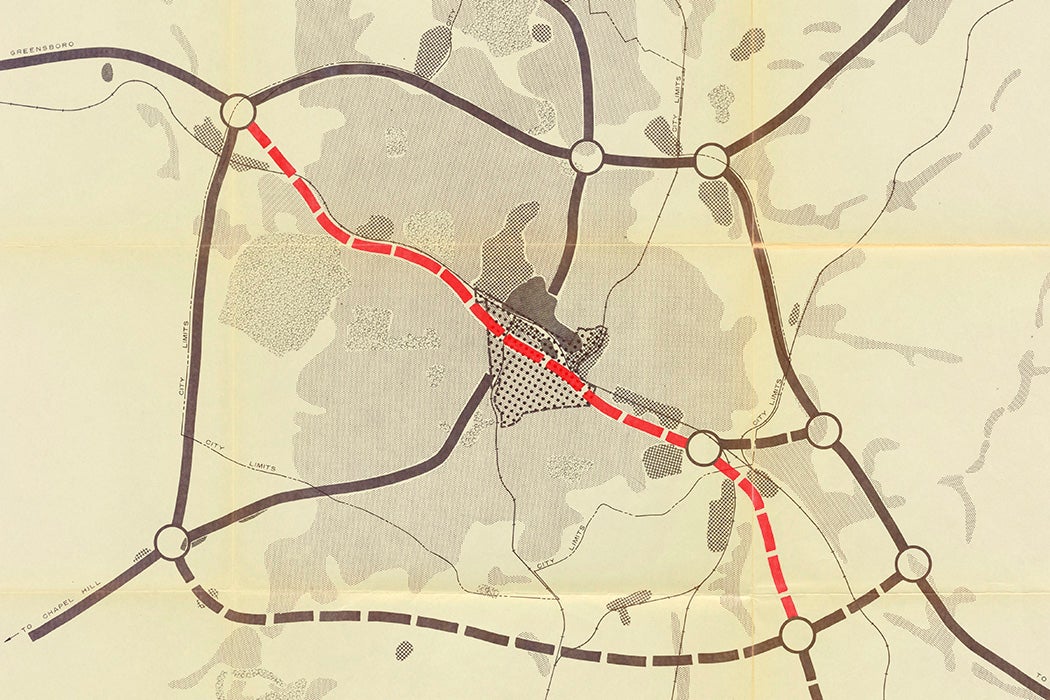In the 1950s and 1960s, under the guise of growth and development, the US federal government initiated the construction of interstate highways. This ambitious project aimed to facilitate the faster and more efficient transportation of people, goods, and services while also preparing for potential wartime logistics. The connectivity offered by these highways made the iconic “US cross-country road trip” a reality, enabling interstate family vacations and connecting coastlines. As sociology scholar Kevin Fox Graham notes, the interstate system was part of a larger project of urban renewal, a federal program designed to “develop blighted areas, close public-private coordination of urban land-use and control, long-term federal loans to cities at low interest rates, and generous tax subsidies and write-offs for local redeveloper.” Urban renewal, particularly through highway development, was marketed to underdeveloped communities as an opportunity to bloom again through long overdue governmental investment.
Underpinning these projects was a troubling logic: the infrastructure interventions helped maintain white supremacy by improving white communities through increased connectivity while rendering African American communities as sacrifice zones. Utilizing redlining maps, government bureaus facilitated the accumulation and preservation of generational wealth through land ownership for white communities while designating racialized communities as blighted. As Leland Ware argues in tracing the legacy of Plessy v. Ferguson (1895) to urban renewal, municipalities exploited eminent domain to seize African American-owned properties, businesses, schools, and community centers. Highways were then constructed to either maintain separation from white communities, segment African American communities from other businesses and neighborhoods, or destroy them altogether.
The story of the once-booming Hayti neighborhood in Durham, North Carolina, exemplifies the devastating impact of urban renewal on African American communities nationwide. As researchers Allison De Marco and Heather Hunt relate, the construction of North Carolina Highway 147, also known as the Durham Freeway, was marketed to Hayti’s residents as a means to better connect those living on the outskirts of Durham with the bustling businesses of the downtown area.
Initially, the community was divided on the opportunity presented to them. Should they trust the intentions of the Durham City Council? Much of the neighborhood would have to be demolished and residents temporarily relocated while the freeway was being built. The city council promised Hayti residents that after the completion of the highway, they would rebuild and improve the segments of the community that had been destroyed, write De Marco and Hunt. The Durham Committee on Negro Affairs (DCNA), a political powerhouse in Durham that still exists today (now the Durham Committee on the Affairs of Black People), believed that urban renewal would bring governmental investment to raise property values, improve public infrastructure, and create business opportunities. Consequently, the DCNA encouraged Durham’s Black community to vote in favor of the bond referendum that would allow the urban renewal plan to continue.
Ultimately, the promise of a renewed Hayti never materialized. Approximately 500 businesses and 4,000 families were displaced, report De Marco and Hunt; many never returned. According to the Renewing Inequality project, nationwide, the federal Urban Renewal program “displaced tens of thousands of families each year, with families of color displaced at rates far higher than their share of the population.” By 1974, at least 600 municipalities had displaced families through federally funded urban renewal projects.
“African American neighborhoods across the country…were destroyed at disproportionate rates,” the research team reports.
The residents of Hayti still haven’t been properly compensated for the loss of their homes, workplaces, places of worship, schools, and community. But the effects were not and are not solely socioeconomic. Living in proximity to a major freeway has had detrimental environmental health effects on those who live in Hayti. Air pollutants from automobiles, such as carbon dioxide, carbon monoxide, particulate matter, nitrous oxides, and hundreds of other chemicals, are found in high concentrations on highways such as the Durham Freeway. A community study of Hayti commissioned by the City of Durham found that residents of the Hayti community are disproportionately exposed to these toxic chemicals, causing higher rates of asthma, cardiovascular disease, impaired lung development, birth complications, childhood leukemia, and premature death.
Weekly Newsletter
The consequences of the construction of the Durham Freeway still reverberate in Hayti today. Willa McKeithan, a local business owner, noted that she “was told [she] would be able to rent, lease, or buy a building and have more chairs in [her] beauty parlor to rent to other operators… Almost 30 years have passed, and [she] still operates a single chair in [her] home.”
Yet, there are still opportunities to promote environmental justice. Significant investment in communities like Hayti—making public transit more available, the planting of more trees, the addition roadside vegetation—could help mitigate lingering impacts and heal toxic legacies. Moving forward, concerted efforts that explicitly uproot systemic racism, such as substantial community investments and improved public infrastructure, are crucial to addressing and healing the enduring impacts on communities like Hayti.







